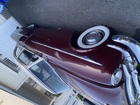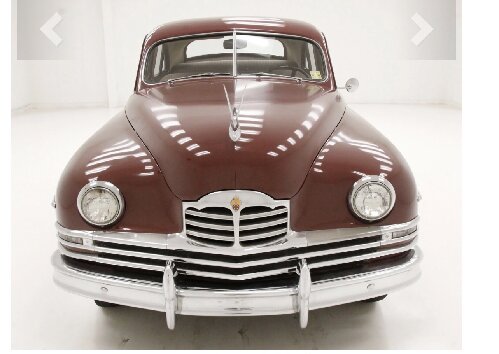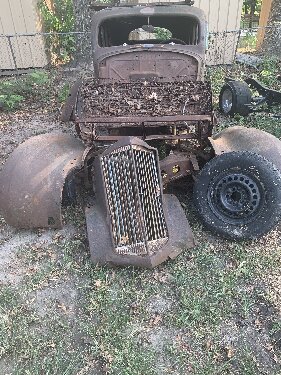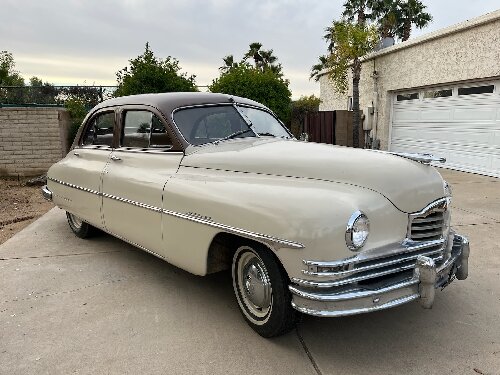|
Re: 356 CI Compression Ratio
|
||||
|---|---|---|---|---|
|
Home away from home
|
I hate to say this, but it bears being said. Kiss the idea of anything called "fuel economy" good-bye. My grandfather kept meticulous per-tank records of every dime spent for gasoline (and everything else) for his herd, and I don't think that anything ever broke 15MPG, or if it did, it wasn't by much and was a road trip. My 282 Deluxe gets maybe 12MPG, and it's all the equivalent of around-town. I put my "fuel economy" efforts into finding the most economical ethylene-free gas I can and call it a day.
So, my conclusion is, raise the compression for the extra fraction that it brings in performance. Heads are cheap, really, if you shop-til-you-drop. I bought 2 and an oil pan for $75 'Murrikan earlier this year.
Posted on: 12/31 7:34
|
|||
|
If you're not having fun, maybe it's your own damned fault.
|
||||
|
||||
|
Re: 356 CI Compression Ratio
|
||||
|---|---|---|---|---|
|
Home away from home
|
I can get 14 to 16 MPG with a '37 120 conv. coupe. I don't do a lot of city driving. Mixed dirt and 2 lane highway. The carburetor is in poor condition and wasting fuel. I believe a carb overhaul will improve MPG to around 17+. 282 8 with an iron HC head. 4.09 axle 7.00 X 16 bias ply tires.
Last fill-up: 14.48 MPG under less than ideal conditions.
Posted on: 12/31 10:04
|
|||
|
||||
|
Re: 356 CI Compression Ratio
|
||||
|---|---|---|---|---|
|
Home away from home

|
The '49 Golden Anniversary Std 8 (288) w/OD I used to own gave me up to 20mpg but that was on long trips that were all freeway. Mixed it was around 16-18mpg. I had rebuilt the engine (it had low compression prior to) and custom made a set of leaner metering rods for the carburetor and ignition was set not by spec but by ear (which was more advanced than book but that's why they had the "octane adjuster" Vernier scale on the distributor). Interestingly it actually did better at 70mph than at 55-60mph and that's where I would get the 20mpg. Packard offered different metering rods for the Carter carbs to enrich or lean from stock and I had managed to find the specs on them. One can change the metering jets but that changes the entire range whereas the optional rods had different profiles, not just fatter. In this way one can for example keep acceleration about the same but lean cruise.
My '48 Custom 356 w/OD is more like 13mpg in mixed driving (mostly freeway). I haven't messed with the metering rods in it yet but am contemplating bumping the CR before experimenting with mixture and ignition.
Posted on: 12/31 10:57
|
|||
|
1942 Clipper Club Sedan
1948 Custom Touring Sedan (22nd Series) 1955 Patrician Sedan 1955 400 Sedan |
||||
|
||||
|
Re: 356 CI Compression Ratio
|
||||
|---|---|---|---|---|
|
Home away from home
|
Refilled this morning at the same pump as yesterday. Worked out to 15.0 MPG. My carburetor is leaking fuel into the intake. I disabled the choke, yet the car will start with a pump of the pedal and idle and run well with no more than 30 to 45 seconds of warm up. It should not do that with temperatures in the 40 to 50 F range with no choke. The manifold heat valve does work properly, or close to it. I think this car could reach 17 to 18 MPG where I normally drive if the carburetor was rebuilt and the distributor adjusted correctly. A long, open road trip at 55 MPH might yield near 20 MPG.
Posted on: 12/31 14:25
|
|||
|
||||
|
Re: 356 CI Compression Ratio
|
||||
|---|---|---|---|---|
|
Home away from home
|
Scott, your and TxG's, Wat's mpg all sound familiar. I long ago had a 3.9 axled '51 288 (later that year the factory revised to 3.54 like the 327 300/400), got about what the above posters report. However, my '40 120 with 4.09 (instead of 4.36) axle and overdrive, razor tuned, 32 psi cold Denman bias plies, once returned 22.5 mpg.
Yes, really. And much of that was 60-65 mph. My '47 Super Clipper despite a 3.92 rear axle in lieu of usual 4.09 with overdrive and aforementioned 7.5:1 327 head, running 41 psi cold bias- s i z e d 7.00/15 Bridgestone LT radials gets half that. 356 Packards, like an old friend said of his '41 Cad conv. (346-ci L-head) when he left the Navy after War II, would "pass everything but a gas station." However, a 4,300-lb. curb weight, flathead (L-head), 336.7-ci, factory compression 7:1 '51 Lincoln with 3.31 rear end and overdrive for a 2.39 final drive, won that year's Mobil Economy Run Sweepstakes with 25.488 mpg (ton mpg figure of 66.484). Motor Trend's editor Griff Borgeson, who wrote accurately and deeply about many cars both sides of the Atlantic, Channel, observed 24.448 mpg in this same car, which had been torn down and inspected to confirm being entirely stock after impounded when Chrysler complained. Remember weight. For some reason, few old domestic car blokes care about weight. When Bentley coaxed their 278.7-ci F-head six, 3,750-lb.. 3.08:1 axled '52 Continental to 118.75 mph, they did so by greatly increasing tire pressure, removing the spare tire and back seat. Some of us are more interested in absolute speed than acceleration because the higher the former, the more relaxed ambling. The Bentley Continental's 0-60 was 13 seconds, same as a well-tuned 1940-50 356 Packard, tho' the lightweight '40 160 business coupe might manage just over 12 seconds. This aside because long ago, i fawned over Packard Darrins and Continentals. But honest Darrin owners admit that lovely as the 1938-40 editions are, factory cars are better. (1941-42 Darrins shared more factory parts but are to some of us overbearing, blowsy looking.) Continentals have that cartoony rear overhang, and R-R/Bentleys have added, pointless complexity, as well as a nut-for-bolt copy of Packard's Saf-T-Flex i.f.s, abandoned in the '56-on Clouds and S-Types for the same reason Packard also used a conventional GM-type i.f.s. in the 1941-47 Clipers; the lowered floor pan left no room for Saf-T-Flex's long torque arms, and cost cutting at both Packard and in Crewe, England. In short, don't go overboard on compression. A little boost, okay. More important: Look to the "compleat car." And lose weight. Bill Lear said, "I'd sell my grandmother to lose another pound from a Lear Jet." Packards were nonpareil road cars in the '30s and '40s, so don't fathom why most of the preceding may as well be in Latin. According to a Chevron engineer, himself owning an old muscle car, any brand gasoline will last a year so long as not exposed to temperatures much above 80. But Stabil's not a bad idea, the regular not marine type. Keep it simple. Don't reinvent the wheel. Factory standard. Packard knew what they were doing. Nothing you do will make them drive as well as a new Camry. Ferrari friends laughed that a stick Honda Civic of the '90s would outperform their '58 Berlinetta, '59 Pinanfarina coupe, even '63 Lusso; out accelerate, out brake, out corner the fabled Prancing Horses. A late friend owning a parade of high-end '30s, '40s stuff, Delahayes, Hispano K6 and J12, Delage D8, Bugatti Types 57 & 101, '39 Lagonda V-12 Rapide, supercharged '36 Auburn 852 speedster, Marmon 16, said his little Geo Metro "drove better than all that old crap," and his cars, everyone, first ran as intended, t h e n and only then went to the shows. My Super Clipper has lower piston speed than the aforementioned Bentley Continental, which used an engine tracing to the 1922 R-R Model 20, itself cribbed from the '20 Buick Six, though in the words of the respected Laurence Pomeroy, "not so good." Again, R-R was disassembling a new Limited annually in the years just before War II to glean the latest Detroit production tips. My '47 Super is a Buick Roadmaster according to Packard, not a bad thing. If you fancy the '30s fire trucks and realize Duesenbergs overrated, overpriced (then and now), overhyped, taking nine years and several iterations to find homes for only 480 editions, then 385-ci Chrysler Imperial/Packard/Pierce-Arrow eights are the way to go. If you really want the overkill of a V-12, a Pierce over a Packard, tho' both obviously good cars. Pardon the verbiage, but what i am t r y i n g to impart is perspective. Without that, and appreciation for the real thing, what's left of the old car hobby drifts more and more to retrorods, Frankencars. We've seen '30s Packard Super Eights and Twelves with big block Chevy crate motors. Enjoy the ride. Hope springs eternal, sports fans. Happy New Year.
Posted on: 12/31 17:03
|
|||
|
||||
|
Re: 356 CI Compression Ratio
|
||||
|---|---|---|---|---|
|
Home away from home
|
One easy thing to check as far as power/performance:
Be sure your accelerator linkage is actually opening the throttle fully when the pedal is to the floor. Many linkages on older cars do not. Most can be adjusted to correct the problem.
Posted on: 12/31 18:16
|
|||
|
||||
|
Re: 356 CI Compression Ratio
|
||||
|---|---|---|---|---|
|
Home away from home

|
Quote:
That's generally true, but back in the late 40's automotive gasoline was about 72 octane (AKI). In the 50's it was around 80. It continued to increase until it peaked at 90 in 1974. It's currently running around 87. Consider what Packard had to accommodate in the design. Compression ratios increased industry-wide as octane increased. From the '48 Packard at 6.85, a '54 Packard had 8.70 compression. A '56 Packard V8 had 10.0 compression (which required premium / "ethyl"). BTW, there's a movement to eliminate multigrade gasoline and settle on a single grade of 95-97 so manufacturers can all take advantage of even higher compression ratios, which are now averaging about 10.5 but they want to go even higher for greater efficiency. Today's regular at 87 is a long way from the 76 of 1948, so a 1948 engine can benefit from a CR bump and run more efficiently. Edit: Trivia note -- Union 76 gas stations got their name from the octane rating of their premium "ethyl" gasoline back when they originated in 1935, 76, which had a patriotic sound to it alluding to the year 1776, hence Union 76.
Posted on: 12/31 18:16
|
|||
|
1942 Clipper Club Sedan
1948 Custom Touring Sedan (22nd Series) 1955 Patrician Sedan 1955 400 Sedan |
||||
|
||||
|
Re: 356 CI Compression Ratio
|
||||
|---|---|---|---|---|
|
Home away from home
|
More compression on the older models, within reason, will improve performance and economy, and can offset power losses due to higher altitude operation and ethanol adulterated fuel. More compression will place higher demands on the ignition system, but a system in good order will have no problem, and combustion chamber deposits will be reduced. The HC head for the 120 model 282 raised compression from about 7:1 to about 7.5:1, and I believe that Packard claimed power increase of 3 to 4%, which would be in the 4 to 5 HP range. A similar gain in fuel efficiency might be expected, provided operating parameters remained unchanged.
Posted on: 12/31 18:47
|
|||
|
||||
|
Re: 356 CI Compression Ratio
|
||||
|---|---|---|---|---|
|
Home away from home

|
Just curious. Anyone know what the Edmunds aluminum head did for the 356 in terms of compression ratio?
Posted on: 1/9 22:40
|
|||
|
1942 Clipper Club Sedan
1948 Custom Touring Sedan (22nd Series) 1955 Patrician Sedan 1955 400 Sedan |
||||
|
||||

 Packard_Straight_8_Compression_Ratios.pdf
Packard_Straight_8_Compression_Ratios.pdf






